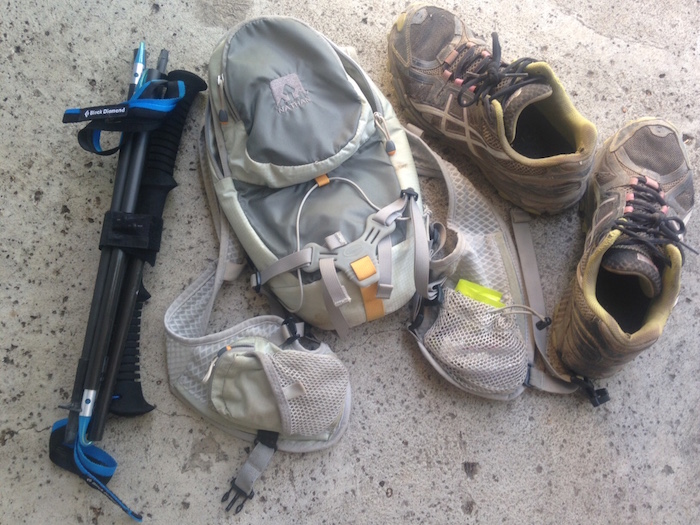
After Born to Run hit stands in 2009 and barefoot running swept the world, I gradually began to hang onto my running shoes. The standard guideline to “replace running shoes after 300–500 miles” got tossed aside like yesterday’s stinky inserts. It seemed to make sense; if running barefoot is good for the body and sole, then how can shoes that are a little worn be bad? (Plus, it saves a whole lot of money.)
My current pair of trail shoes has lasted some two years, maybe even more, as my record keeping of late has been a bit spotty. By “lasted,” I mean the holes on the sides and toes now let in enough dirt and rocks that I’m motivated to replace the shoes.
This pair has also become quite aromatic. Though I rinse out my trail shoes on a regular basis, these are so stinky as to have been banished to the front porch when not in use (outdoor storage being another factor in their breakdown, I’m sure).
Add a nagging knee and I was forced to acknowledge that this pair of shoes was shot, and all roads led to the shoe store.
And herein lies the source of this rant: my shoe no longer exists.
What Happened to My Shoe?
Every runner in the world has, at one time or another, wailed in despair, “Why did they mess with my shoe? I always wear [brand of shoe] and the [specific model] was perfect! I’ve run in these for [a short or surprisingly long amount of time]. And it’s only [number of days] until my big run!”
Teeth are gnashed, curse words uttered, tears sometimes shed; friends console by helpfully referring online resources that specialize in discontinued shoe models. Sometimes, you get lucky and one last pair of dusty, deeply discounted shoes is located in a remote warehouse but, more often than not, a change must be made.

I had planned to purchase new shoes for the Grand Canyon trip this week, just in time for one final long run, a shorter outing the next week, and taper to follow. But frugalness tripped me up. In the past, I’d rotate between two pairs, one shoe for less technical terrain and another for beast trails. This strategy provided a fall-back, each pair lasting just a little longer, the inevitable search for a replacement staggered and postponed. There was always one familiar, broken-in pair of shoes ready in the closet. Lately, however, I’d relied on one heavily used pair of all-purpose trail shoes.
Every dog has its day, and my dogs had been barking, particularly on last weekend’s rocky, rolling jaunt over some 16 to 18 miles. Except, with no shoes to be found, it appears I’m screwed on a replacement.
Why Mess with the Shoe?

Setting aside the whole “we’re here to make money by selling a product” business rationale, shoe companies typically make changes based on new science and technology, along with consumer demands.
Just as it changed my attitude, Born to Run generated new interest in footwear theories. Granted, Nike had sounded the starting gun on the minimalist movement in 2005 by introducing the Free (and yes, there was a trail version, which I ran in…until they dyed my feet fuchsia). The barefoot movement had scientists looking for hard information to back claims. In a 2008 online summary of studies, British Journal of Sports Medicine found no evidence that selecting shoes with motion control features and higher heels by diagnosing foot type benefitted distance runners. New theories have led companies to reduce the drop (heel-to-toe height difference) to no more than 6 millimeters (about 1/4 inch), a substantial difference from 12 to 15mm drops of the past. Zero-drop shoes, which have a 1–4mm heel-to-toe differential, have become the current rage.
Why such a low drop? Though it will take years to finalize studies, a lower drop results in shorter strides and less heel striking, which means less wear-and-tear on knees. In other words, strides are more natural (even though practice is required to transition from the cushioned shoes runners are accustomed to). So science, or our understanding of it, has prompted shoe companies to change designs.
We users also push companies to change. When I interviewed Karl “Speedgoat” Meltzer for an AFM web article (“Speedboat Karl Meets Bandera 100K”), I was intrigued by the thick, puffy shoes he wore (Hoka road shoes). Olympic medalist and Austinite Leo Manzano has made the switch in training to Hoka One Ones, and the example set by role models like these has encouraged interest in what’s being called the “maximalist” movement. According to NPR’s Only a Game, it’s word of mouth that’s driving interest in Hokas rather than scientific claims. Who knows where this public interest (and resulting dollars) will spur other companies to make changes in design?
//embed.wbur.org/player/onlyagame/2015/02/21/maximalist-running-shoes-trend
I’ll take my shoe search online, grumpy about spending my dollars online instead of in town. If that fails, I’ll venture out in hopes of finding a new favorite. At the least, I want to avoid introducing a new wrinkle into my bucket-list event.
At worst, I can always wear my old — aka “minimalist” — shoes.
Want to Read More?
“A Closer Look at Minimalist Running Shoes,” Podiatry Today
ACSM Guide to Selecting Running Shoes (American College of Sports Medicine brochure on finding the best running shoes for you)



One thought on “Every Runner’s Shoe Rant”